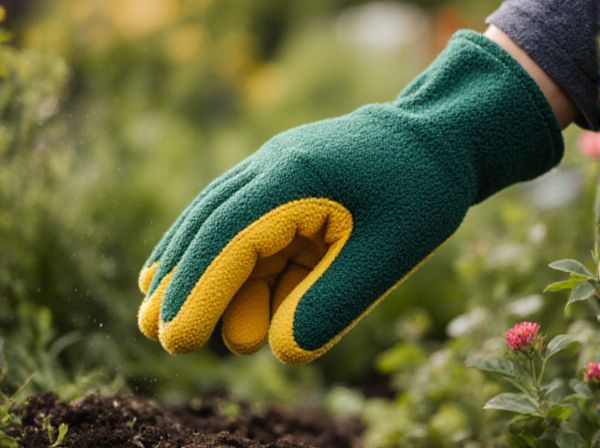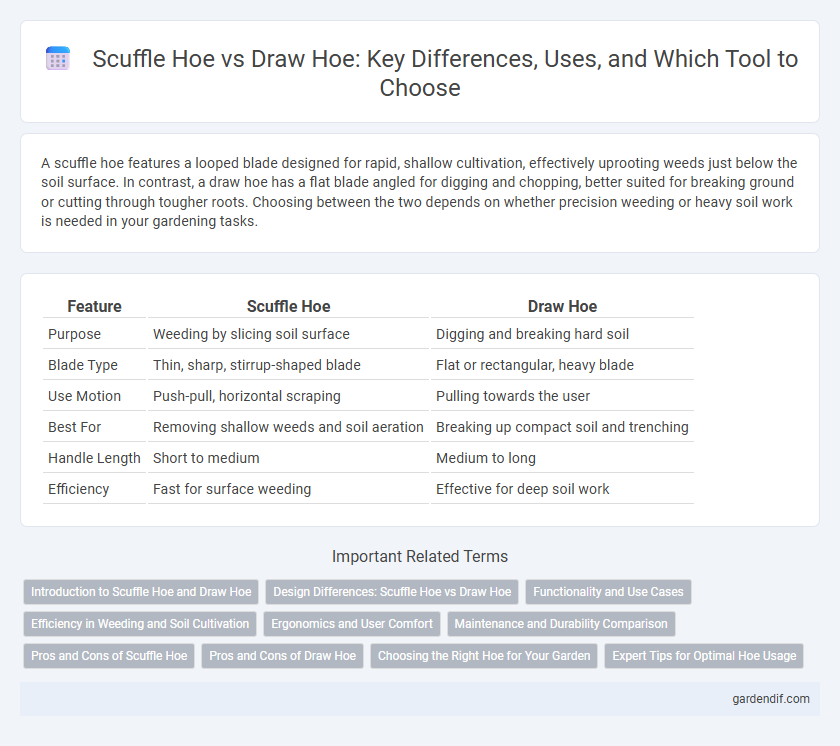
Scuffle hoe vs Draw hoe Illustration
A scuffle hoe features a looped blade designed for rapid, shallow cultivation, effectively uprooting weeds just below the soil surface. In contrast, a draw hoe has a flat blade angled for digging and chopping, better suited for breaking ground or cutting through tougher roots. Choosing between the two depends on whether precision weeding or heavy soil work is needed in your gardening tasks.
Table of Comparison
| Feature | Scuffle Hoe | Draw Hoe |
|---|---|---|
| Purpose | Weeding by slicing soil surface | Digging and breaking hard soil |
| Blade Type | Thin, sharp, stirrup-shaped blade | Flat or rectangular, heavy blade |
| Use Motion | Push-pull, horizontal scraping | Pulling towards the user |
| Best For | Removing shallow weeds and soil aeration | Breaking up compact soil and trenching |
| Handle Length | Short to medium | Medium to long |
| Efficiency | Fast for surface weeding | Effective for deep soil work |
Introduction to Scuffle Hoe and Draw Hoe
The scuffle hoe features a sharp, looped blade designed for rapid side-to-side motion, efficiently cutting weeds just below the surface without disturbing the soil excessively. In contrast, the draw hoe has a flat, broad blade ideal for chopping and digging tasks, providing deeper soil penetration and better control for breaking up compacted ground. Both tools are essential in gardening and farming, each suited for specific weeding and soil preparation needs.
Design Differences: Scuffle Hoe vs Draw Hoe
The scuffle hoe features a looped or oscillating blade designed for pushing and pulling just beneath the soil surface, making it ideal for weeding without disturbing deeper roots. In contrast, the draw hoe has a flat, sharp blade attached at a right angle to a long handle, enabling it to cut or break up soil by pulling the tool toward the user. These design differences impact their efficiency in tasks: the scuffle hoe excels at shallow weed removal, while the draw hoe is better for heavier cultivation and soil preparation.
Functionality and Use Cases
A scuffle hoe, designed with a looped blade that moves back and forth, excels in swiftly cutting weeds just below the soil surface, making it ideal for light cultivation and weed control in garden beds. In contrast, a draw hoe features a flat, sharp blade used by pulling towards the user, effectively breaking up compacted soil and shaping rows, which suits tasks like trenching and soil aeration. Choosing between a scuffle hoe and a draw hoe depends on the gardening need: rapid weed removal versus soil preparation and shaping.
Efficiency in Weeding and Soil Cultivation
A scuffle hoe provides superior efficiency in weeding through its ability to cut weeds just below the soil surface with a push-pull motion, minimizing soil disturbance. In contrast, a draw hoe excels at soil cultivation by breaking up compacted ground and aerating deeper layers, enhancing root penetration. Choosing the right tool depends on the balance between targeted weed removal and thorough soil preparation for optimal gardening results.
Ergonomics and User Comfort
The scuffle hoe features a looped blade ideal for pushing and pulling motions, reducing wrist strain through its ergonomic design and lightweight frame. In contrast, the draw hoe employs a flat blade requiring a pulling action that may increase user fatigue during extended use. User comfort significantly improves with the scuffle hoe's adjustable handle and cushioned grip, promoting natural wrist alignment and minimizing repetitive stress injuries.
Maintenance and Durability Comparison
Scuffle hoes require less frequent sharpening and have a durable blade designed for scraping between rows with minimal wear, making maintenance straightforward. Draw hoes demand regular blade sharpening due to their chopping action, but their robust construction withstands heavy-duty use over extended periods. Both tools offer long-lasting durability, but scuffle hoes excel in low-maintenance efficiency, while draw hoes provide strength for tougher soil tasks.
Pros and Cons of Scuffle Hoe
Scuffle hoes excel at weed control by slicing just below the soil surface, minimizing soil disruption and reducing weed regrowth compared to draw hoes. Their narrow, oscillating blade design requires less physical effort, making them ideal for precision weeding in tight garden spaces. However, scuffle hoes are less effective on hard or compacted soil and can struggle with deep-rooted weeds, where draw hoes offer more aggressive soil penetration and uprooting capability.
Pros and Cons of Draw Hoe
The draw hoe offers precise soil cultivation with its narrow blade, making it ideal for weeding and shaping garden beds. Its lightweight design enhances maneuverability, but it may require more physical effort compared to the scuffle hoe for breaking compacted soil. The draw hoe's ability to reach tight spaces provides targeted control, but it can be less efficient for large-scale soil turning or surface scraping tasks.
Choosing the Right Hoe for Your Garden
Choosing the right hoe for your garden depends on the task and soil type. A scuffle hoe, with its sharp, oscillating blade, excels at cutting weeds just below the soil surface in loose, cultivated soil. In contrast, a draw hoe, featuring a flat blade designed for pulling toward you, is better suited for shaping soil, creating furrows, and heavier digging in compacted ground.
Expert Tips for Optimal Hoe Usage
Scuffle hoes excel in light weed control with their oscillating blade, allowing precise surface cultivation without damaging roots, making them ideal for garden beds and fine soil. Draw hoes feature a flat blade used for heavier tasks like breaking up hard soil and digging furrows, offering better leverage with a pull motion that enhances efficiency in tougher conditions. Expert gardeners recommend using the scuffle hoe for daily maintenance and the draw hoe for intensive soil preparation to maximize productivity and crop health.
Scuffle hoe vs Draw hoe Infographic

 gardendif.com
gardendif.com